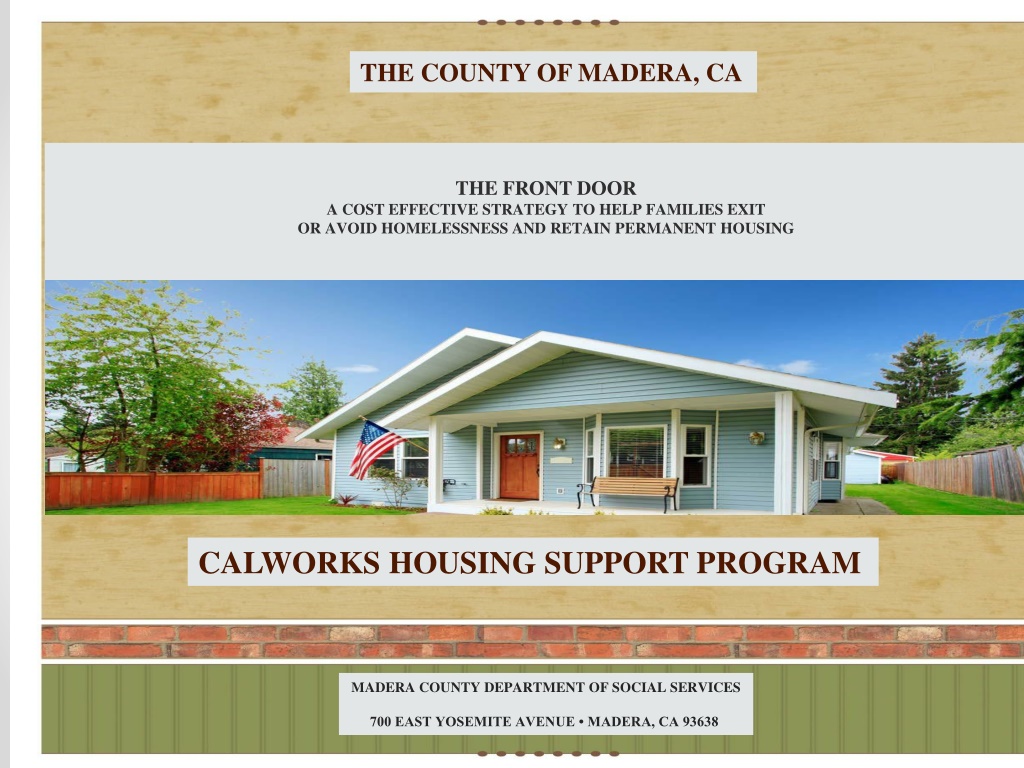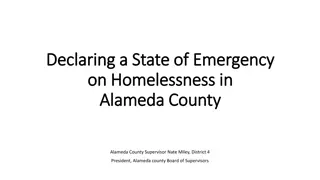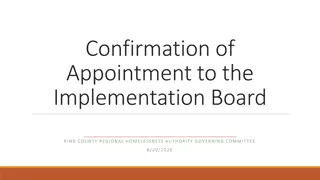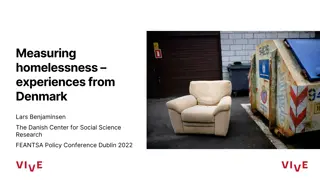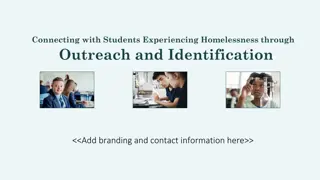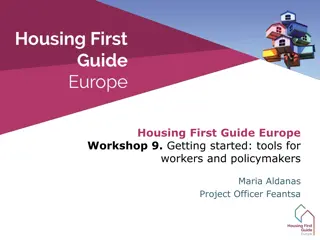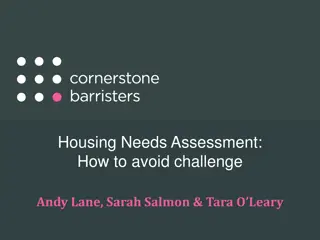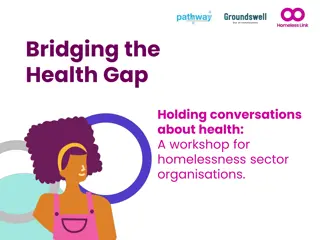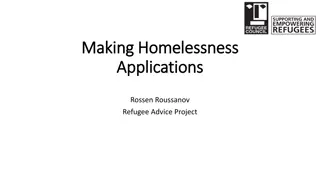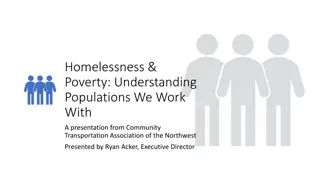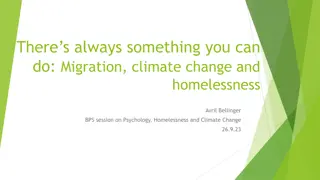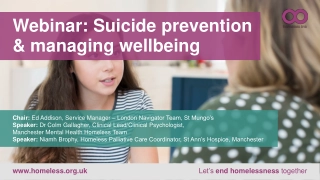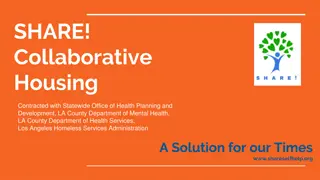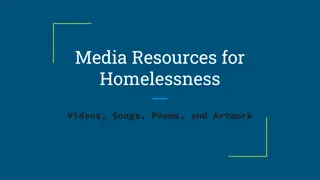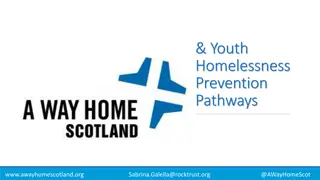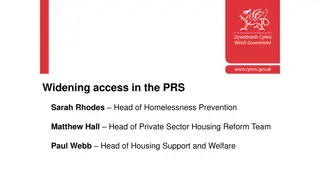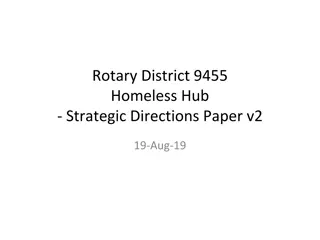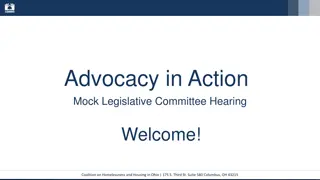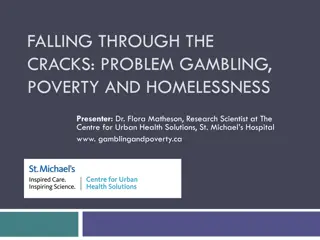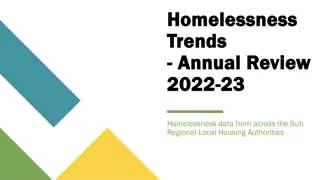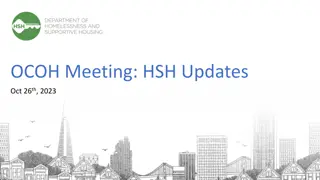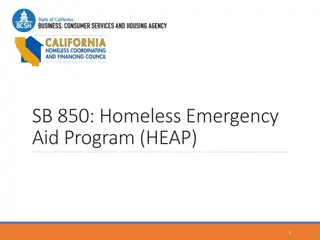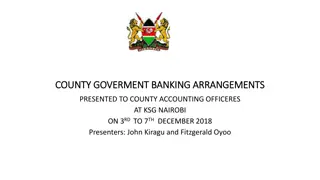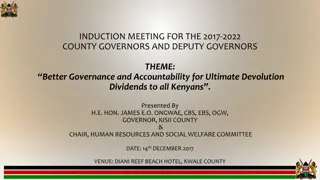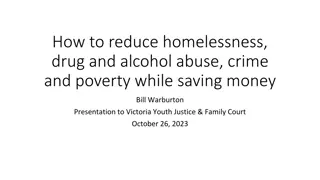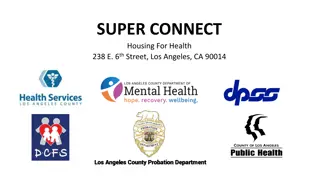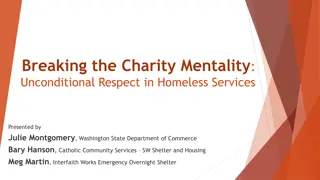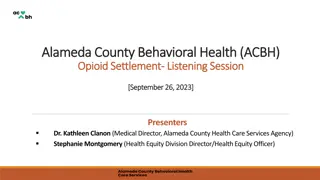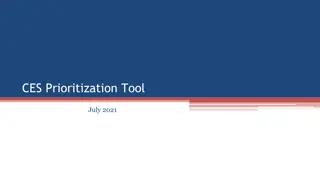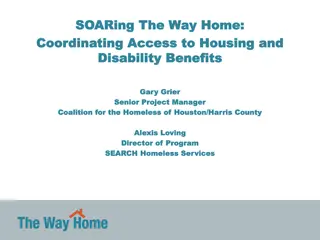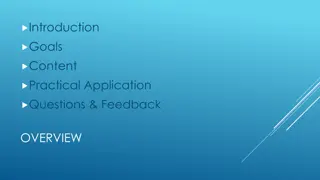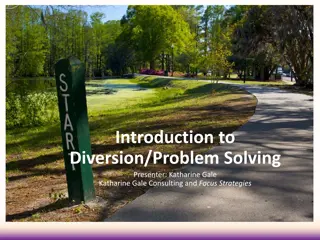Cost-Effective Strategies to Combat Homelessness in Madera County, CA
The County of Madera in California has implemented various programs and services to help families exit or avoid homelessness and retain permanent housing. Initiatives like CalWORKs Housing Support Program, Community Partnership of Madera County, and Housing Authority of Madera County focus on providing housing support, stabilization services, financial counseling, and mental health resources. These efforts aim to address barriers to housing, support family stability, and prevent homelessness through a collaborative and comprehensive approach.
Download Presentation

Please find below an Image/Link to download the presentation.
The content on the website is provided AS IS for your information and personal use only. It may not be sold, licensed, or shared on other websites without obtaining consent from the author. Download presentation by click this link. If you encounter any issues during the download, it is possible that the publisher has removed the file from their server.
E N D
Presentation Transcript
THE COUNTY OF MADERA, CA THE FRONT DOOR A COST EFFECTIVE STRATEGY TO HELP FAMILIES EXIT OR AVOID HOMELESSNESS AND RETAIN PERMANENT HOUSING CALWORKS HOUSING SUPPORT PROGRAM MADERA COUNTY DEPARTMENT OF SOCIAL SERVICES 700 EAST YOSEMITE AVENUE MADERA, CA 93638
Community Partner Agencies
Community Partnership of Madera County Child care and preschool readiness programs Regional Head Start Programs Senior Bus Transportation Rape/Sexual Assault Services Victim and Witness Services Permanent Supportive Housing for chronically homeless women through the Shunammite Place Domestic Violence Emergency Shelter through the Martha Diaz Battered Women s Shelter Address Housing Access (Emergency shelter, supportive housing, and working with Partner agencies Stabilization of family (access to preschool readiness, child care and Head Start) Financial counseling (classes, money management)
Housing Authority of Madera County Develop Additional Landlord-owned Rental Housing Resources Provide Management and oversight of the Housing stock and its quality Housing Identification Rent/Move Assistance Landlord Outreach and Engagement Housing Search and Placement Housing Barrier Identification and Assessment
Madera County Behavioral Health Services Mental Health First Aid Mental Health Substance Abuse Domestic Violence Refer to: Address Housing Access Stabilization of the Families (community resources) Credit Barriers Legal Services
Family Stabilization Services Assessment Tool Self Assessment Functioning Evaluation SAFE Form
MADERA COUNTY DEPARTMENT OF SOCIAL SERVICES CalWORKs/WELFARE-TO-WORK/CHILD WELFARE SERVICES PROGRAMS SELF-ASSESSMENT FUNCTIONING EVALUATION NOTE: For persons under 18 years of age, please use the back side of this form for questions 1 7. Yes No I h ave: 1. Lost time from work due to drinking/using drugs. 2. Been annoyed by people who think I should quit drinking/using drugs. 3. Gotten into financial difficulty because of my drinking/drug use. 4. Had a drink/drug in the morning to steady my nerves or get rid of a hangover. 5. Sometimes felt bad or guilty about my drinking/drug use. 6. Felt I should cut down on my drinking/drug use. 7. Had a partial or complete loss of memory (black-out) from drinking/drugs. Currently In last Year More 2 years Someone in my life has: 8. Thrown or broken things or scared me in other ways. 9. Insulted me or my children or called me names in front of others. 10. Behaved in a jealous way towards me or tried to keep me from my family/friends. 11. Threatened to harm him/herself, me and/or my family if I leave. 12. Physically hurt me in some way (pull hair, slap, push, choke, hit, even if it did not leave a mark). I have or one of my family members has: 13. Had thoughts of harming self or someone else. 14. Had major life changes that have been hard to heal with (divorce, death, loss of job). 15. Had changes in my day-to-day life (trouble getting out of bed, change in sleep or eating habits, scary dreams, or not wanting to be with others.) 16. Heard voices that others do not hear or that tell me to do things I don t want to do. 17. Had problems finding a job because of mental illness. 18. Found it hard to focus or remember things (day of the week/important appointments). Currently: 19. I am pregnant. 20.Iamreceivingprenatalcare: 21.Mycurrentmethodofbirthcontrolis: 1st Trimester Mydoctoris: 2nd Trimester 3rd Trimester Currently receiving services from: Family Physician Substance Abuse Services OtherservicesIamreceiving: Mental Health WIC CWS Probation California Department of Rehabilitation Parole Prop. 36 PrintName:(Participant) Participant sSignature: Phone#: Case#:
Housing: NOTE: For persons under 18 years of age. Use in place of questions 1-7 from page 1. 22. Are you homeless or do you believe you will become homeless within the next 72 hours? Yes If you answered yes, please answer the next few questions. 23. Where did you sleep last night? _________________________________________________________________ 24. What other housing options do you have for the next few days or weeks? ______________________________ ______________________________________________________________________________________________ 25. If you are staying in someone else s house, would any issues exist if you remain in your current housing situation? ________________________________________________________________________________________________ ________________________________________________________________________________________________ Could those be resolved with financial assistance, case management or some other services? Yes If yes, what service would be of most benefit? _________________________________________________________ 26. If coming from your own housing unit, is it possible for you to stay in your current housing unit? Yes No What resources would you need to have to keep your housing (financial assistance, case management, mediation, transportation, etc.)? ____________________________________________________________________________ _______________________________________________________________________________________________ 27. If you are worried about your safety, let your caseworker know. No No Yes No ave: Ridden in a car driven by someone (including yourself) who was high or had been using alcohol or drugs? 2. Used alcohol or drugs to relax, feel better about yourself, or fit in? 3. Used alcohol/drugs while you are by yourself, alone? 4. Forgot things you did while using alcohol or drugs? 5. Been told by family or friends that you should cut down on my drinking or drug use. 6. Gotten into trouble while using alcohol or drug. I h 1. Currently In the past year County Use MAD 395 WTW (7/14)
Madera County Housing Support Program Rapid Rehousing Screening Tool
Tenant Screening Barriers (Barriers to Obtaining Housing) Retention Barriers (Barriers to Sustaining Housing) Level of Assistance No significant barriers except financial: very low income, insufficient emergency reserves Level 1 The CalWORKs household will need minimal assistance to obtain and retain housing. The Madera Housing Support (HS) Program offers the following for most Level 1 households: Household has no criminal history Rental history: an established local rental history. No evictions, landlord references are good to fair Credit history is good, with the exception of a few late utility and credit card payments Financial assistance for housing start-up (e.g. first month s rent, security deposit, utility deposit) Initial consultation related to housing search (e.g. where to find rental information, how to complete housing applications, documentation needed) Time-limited rental assistance, per client Housing Plan Home visit/check-in after move-in Offer of services (at tenant request) for up to 3 months. Landlord assistance will likely include only program contact information for tenancy concerns.
Tenant Screening Barriers (Barriers to Obtaining Housing) Retention Barriers (Barriers to Sustaining Housing) Level of Assistance Household has no serious criminal history, but may have a few minor offenses such as moving violations, a DUI, or a misdemeanor Financial barriers include very low income, may have inconsistent employment, poor budgeting skills. Level 2 The CalWORKs household will need routine assistance to obtain and retain housing. The HS Program offers the following for most Level 2 households: No serious mental illness or chemical dependency that affects housing retention. May have some level of depression or anxiety or problems responding to conflict. Rental history is limited or out-of- state. May have 1-2 explainable evictions for non-payment. Prior landlords may report a problem with timely rent. Financial assistance for housing start-up Time-limited rental assistance, per client Family Stabilization Plan Initial consultation and ongoing assistance with housing search, including bus tickets as needed Development of Housing Plan to work on any identified retention barriers Weekly home visits for first two months; then reduce to bi-weekly or monthly as most Housing Plan goals are met. Services available for up to 6 months, depending on housing problems and progress toward Housing Plan goals. May lack awareness of landlord-tenant rights/responsibilities. Credit history shows pattern of late or missed payments. May have minor problems meeting basic household care/cleaning. May have been homeless once before. Landlord assistance: 6 month availability: landlord can call with tenancy issues and program will respond. Program will check in with landlord periodically for updates. HS Program will relocate household if landlord is considering eviction.
Tenant Screening Barriers (Barriers to Obtaining Housing) Retention Barriers (Barriers to Sustaining Housing) Level of Assistance Household may have some criminal history, but none involving drugs or serious crimes against persons or property. Household is very low income, has periods of unemployment, no emergency reserves, lacks budgeting skills. Level 3 The CalWORKs household will need more intensive and/or longer assistance to obtain and retain housing. The HS Program offers the following for most Level 3 households: Rental history includes up to 3 evictions for non-payment. Prior landlord references fair to poor. Partial damage deposit returned. Some complaints by other tenants for noise. Problems with mental health or alcohol/substance use that somewhat impacts compliance with tenancy requirements. Financial assistance for housing start-up Time-limited rental assistance, per client Family Stabilization Plan. Initial consultation and ongoing assistance with housing search, including bus tickets as needed. Staff may accompany client to the landlord interview. Development of Housing Plan to work on any identified retention barriers. Weekly home visits for first two months; then reduce to bi-weekly or monthly as most Housing Plan goals are met. Include unannounced drop-in visits. Services available for up to 9 months, depending on housing problems and progress toward Family Stabilization Plan goals. May have deficits in care of apartment, landlord-tenant rights/responsibilities, and communications skills with landlord and/or other tenants. Credit history includes late payments and possible court judgments for debt, closed accounts. Conflict may exist in household. May have lost housing and been homeless several times in past. Landlord assistance: 9 month availability; landlord can call with tenancy issues and program will respond even after services end. Program will check in with landlord periodically for updates. HS Program will relocate if an eviction is being considered. If household will not leave, program may pay court costs. Program may pay or repair damages.
Tenant Screening Barriers (Barriers to Obtaining Housing) Retention Barriers (Barriers to Sustaining Housing) Level of Assistance Level 4 The CalWORKs household will need more intensive and longer assistance to obtain and retain housing. The HS Program offers the following for most Level 4 households: Criminal history, violations may include drug offense or crime against persons or property Extremely low income, no emergency reserves, bank accounts closed, lacks budgeting skills. May be using drugs/alcohol and/or has mental health problems. May have conflict with child/ren or partner. May lack ability to care for apartment or communicate appropriately with landlord and other tenants. Rental history includes up to five evictions for non-payment and/or lease violations. Landlord references poor. Security deposit may have been kept due to damage to unit. Financial assistance for housing start-up Time-limited rental assistance, per client Family Stabilization Plan Initial consultation and ongoing assistance with housing search, including bus tickets as needed. Staff may accompany client to the landlord interview. Development of Housing Plan to work on any identified retention barriers Weekly home visits for first two months; then reduce to bi-weekly or monthly as most Housing Plan goals are met. Include unannounced drop-in visits. Services available for up to 12 months, depending on housing problems and progress toward Family Stabilization Plan goals. Has likely been homeless multiple times or for more extended periods. Credit history is poor, late payments, may include judgment for debt to a landlord, closed accounts. Landlord assistance: 12 month availability; landlord can call with tenancy issues and program will respond; ongoing option to call even after Rapid Re-Housing services are ended can
Tenant Screening Barriers (Barriers to Obtaining Housing) Retention Barriers (Barriers to Sustaining Housing) Level of Assistance be offered or negotiated on a case-by-case basis. Program will check in with landlord monthly (or more often if landlord prefers) for updates/issues. May pay an additional damage deposit and/or last month s rent in addition to normal start-up costs. HS Program will relocate household if an eviction is being considered. If household will not leave, program may pay court costs of eviction. Program may pay or repair damages. Level 5 The CalWORKs Household needs longer or more intensive services; may need staff with more professional training. HS Program refers household to appropriate program thru Madera Behavioral Health, for Family Stabilization Program services or other local resources. Active and serious chemical dependency or mental illness. Extensive criminal background. Extremely poor rental history, multiple evictions, serious damage to apartment, complaints. Unable to comply with lease requirements or interact positively with landlord/tenants; poor apartment management skills, out-of-control behaviors by adult or child/ren. Credit history includes multiple judgments, unpaid debts to landlords, closed accounts. May have experienced chronic homelessness (multiple and/or extended periods of homelessness).
Madera County Housing Support Program Family Stabilization (FS) Plan
County of Madera-Administrative Services Phone: (559) 662-8300 Fax (559) 675-7983 Worker Name:____________________________ Worker ID:_______________________________ Worker Phone Number:____________________ Date:____________________________________ Case Name:______________________________ Case Number:____________________________ Family Stabilization Plan _________________________________________________________________________________________________ _____________________________________ _____________________________________ _____________________________________ Family Situation Name DOB Language Program Program Status Months Left Concerns School Attendance Name School Name Attendance Status Status Date Needs Name Need Type Date Name Date Need Type FS Plan (04/2014) Page 1 of 3
Strengths Name:______________________________________ Degrees Degree Type Degree Title Currently In School School Type Program Name Completion Date Skills & Strengths Skill Strength Comments: Comments: Employment Employer Job Title Hours/Week Name:______________________________________ Degrees Degree Type Degree Title Currently In School School Type Program Name Completion Date Skills & Strengths Skill Strength Comments: Comments: Employment Employer Job Title Hours/Week FS Plan (04/2014) Page 2 of 3
Desired outcomes and strategies Timetable _ _____________ to _____________ Goals Comments:_______________________________________________________________ ________________________________________________________________________ _____________ to _____________ Barrier Removal Goals Action Steps 1.___________________________________________________________________ 2.___________________________________________________________________ 3.___________________________________________________________________ 4.___________________________________________________________________ 5.___________________________________________________________________ _____________ Comments:___________________________________________________________ _____________________________________________________________________ _____________ to _____________ Short Term Employment Goals _____________ Action Steps 1.__________________________________________________________________ 2.__________________________________________________________________ 3.__________________________________________________________________ 4.__________________________________________________________________ 5.__________________________________________________________________ Comments:__________________________________________________________ ____________________________________________________________________ Notes ________________________________________ Client Signature ________________________________________ Case Manager Signature FS Plan (04/2014) Page 3 of 3 _________________________ Date _________________________ Date
Identification and Referral Process
New CalWORKs Applicant Initially screened for eligibility by the Rapid Service Eligibility Worker (EW) Unit (RSU) Eligible: Will refer to the Family Stabilization Employment and Training Worker (ETW) ETW will complete the SAFE form to determine severity of homelessness ETW will use the Rapid Rehousing Screening Tool to assist in determining what Level of Service would be provided Family Stabilization Plan is developed with the client to identify Family Situation, Needs, Strengths and Strategies to reach desired Outcomes Referrals completed to community resources as needed
Ongoing CalWORKs Client Ongoing EW or ETW after self disclosure will refer client to the Family Stabilization ETW ETW will then follow the same procedure as a new applicant
Ineligible CalWORKs applicants EW will discuss current situation with applicant to identify their needs EW will direct the applicant to community resources where they may inquire about services to meet their needs
Partner Agency Referrals Once homelessness is identified as an issue, will discuss available services they provide and those by Department of Social Services (DSS) If individual indicates currently receiving CalWORKs services through DSS, the referring Agency will contact the FS ETW to meet the individual at the partner agency s office while client is still there If the individual is not receiving DSS services, they will be encouraged to apply but will also be informed of the available community resources to seek assistance
We are looking forward to the Opportunity to Address the needs of this Population!! Thank you!! Any Questions??
Resources for Documents Step 1: Use the Family Stabilization assessment tool (SAFE)(This was a Madera County provided document). Step 2:Risk Level Determination (use Table 3 Front Door Model of identified risk, page 28 of proposal. (Front Door diversion program intervention. Diversion Program. http://www.endhomelessness.org/library/entry/closing-the-front-door-creating-a-successful-diversion -program-for-homeless Step 3: Use the Rapid Rehousing Screening Tool (Exhibit B) to identify services that are to be offered/establish length of service intervention. (http://www.endhomelessness.org/library/entry/rapid-re-housing-triage-tool1 ) Step 4: The use of the Action Plan from C-IV was used to create the Family Stabilization Plan.
